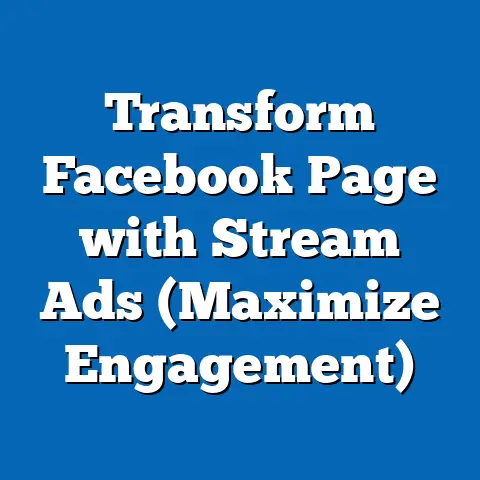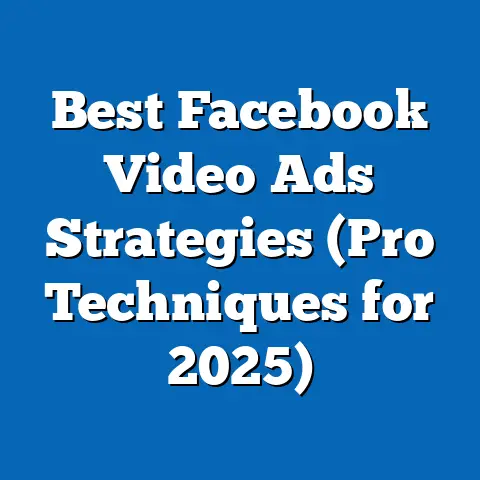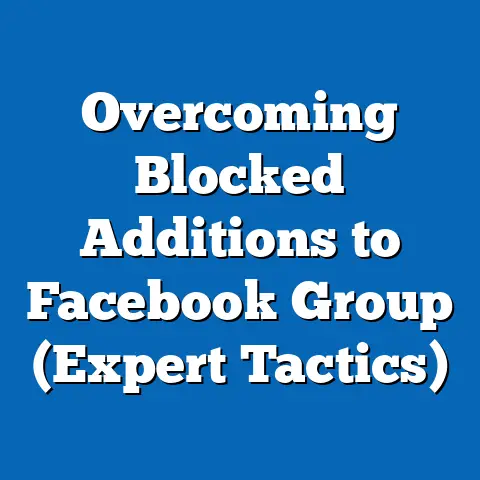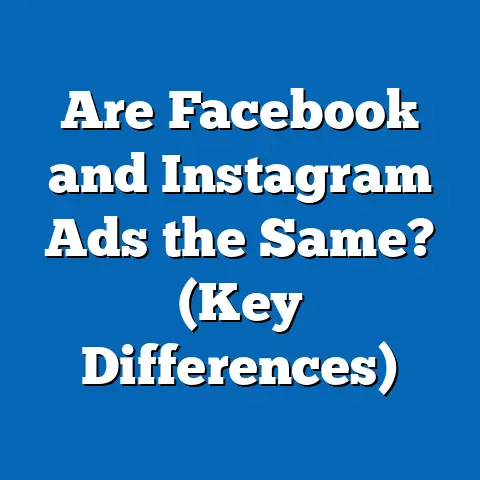Master Facebook Ads ROI (Unlock Average CPI Secrets)
The digital marketing landscape is a constantly shifting terrain, and navigating it successfully requires both a keen understanding of the fundamentals and the ability to adapt to new strategies. One area where this is particularly true is Facebook Ads. As a platform, Facebook offers unparalleled reach and targeting capabilities, making it an invaluable tool for businesses of all sizes. However, simply running ads isn’t enough. To truly succeed, you need to understand how to optimize your campaigns for maximum return on investment (ROI).
ROI, in its simplest form, is the measure of profit you generate for every dollar you spend. In the context of Facebook Ads, it’s about ensuring that the money you invest in advertising translates into tangible business outcomes, whether that’s increased sales, leads, or brand awareness. But how do you achieve this elusive ROI? That’s where understanding key metrics like Cost Per Install (CPI) comes in.
For app developers and marketers, CPI is a critical metric that directly impacts their ROI. It tells you exactly how much you’re paying for each new user you acquire through your Facebook Ads. A lower CPI means you’re getting more users for your money, which directly translates to a higher ROI.
Understanding Facebook Ads and ROI
Facebook Ads are more than just pretty pictures and catchy slogans. They’re a sophisticated system designed to connect businesses with their target audiences. To truly master Facebook Ads and drive ROI, you need to understand the underlying mechanics of the platform.
The Mechanics of Facebook Ads
Facebook Ads operate on a complex algorithm that takes into account various factors to determine which ads are shown to which users. Here’s a breakdown of the key components:
-
Targeting Options: Facebook offers an incredibly granular level of targeting, allowing you to reach users based on demographics, interests, behaviors, and even connections. This means you can tailor your ads to very specific segments of the population, increasing the likelihood of engagement and conversions. I’ve personally seen campaigns achieve significantly higher ROI simply by refining the targeting based on user data and insights.
-
Ad Formats: From image ads and video ads to carousel ads and collection ads, Facebook offers a diverse range of ad formats to suit different marketing objectives. Each format has its own strengths and weaknesses, and choosing the right one is crucial for capturing attention and driving action.
-
Bidding Strategies: Facebook Ads operate on an auction-based system, where advertisers bid against each other to have their ads shown to users. You can choose from various bidding strategies, such as cost-per-click (CPC), cost-per-impression (CPM), and cost-per-action (CPA), each with its own advantages and disadvantages. Selecting the right bidding strategy depends on your campaign goals and budget.
-
Ad Relevance Score: Facebook assigns a relevance score to each ad based on how well it resonates with the target audience. A higher relevance score means your ad is more likely to be shown to users and at a lower cost. This is why creating engaging and relevant content is so important.
Targeting Options: Facebook offers an incredibly granular level of targeting, allowing you to reach users based on demographics, interests, behaviors, and even connections. This means you can tailor your ads to very specific segments of the population, increasing the likelihood of engagement and conversions. I’ve personally seen campaigns achieve significantly higher ROI simply by refining the targeting based on user data and insights.
Ad Formats: From image ads and video ads to carousel ads and collection ads, Facebook offers a diverse range of ad formats to suit different marketing objectives. Each format has its own strengths and weaknesses, and choosing the right one is crucial for capturing attention and driving action.
Bidding Strategies: Facebook Ads operate on an auction-based system, where advertisers bid against each other to have their ads shown to users. You can choose from various bidding strategies, such as cost-per-click (CPC), cost-per-impression (CPM), and cost-per-action (CPA), each with its own advantages and disadvantages. Selecting the right bidding strategy depends on your campaign goals and budget.
Ad Relevance Score: Facebook assigns a relevance score to each ad based on how well it resonates with the target audience. A higher relevance score means your ad is more likely to be shown to users and at a lower cost. This is why creating engaging and relevant content is so important.
How Facebook Ads Work: Cost and Effectiveness
The cost of running Facebook Ads can vary widely depending on several factors, including your target audience, ad format, bidding strategy, and ad relevance. However, the potential reach and engagement of Facebook Ads make them a powerful tool for businesses of all sizes.
The effectiveness of your Facebook Ads campaign hinges on your ability to create compelling content that resonates with your target audience. This means understanding their needs, interests, and pain points and crafting ads that address those concerns. It also means continuously testing and optimizing your campaigns to identify what works best.
I remember one campaign I ran for a local bakery. Initially, we were targeting a broad audience with generic ads. The results were lackluster. However, after segmenting the audience based on their interests (e.g., cake lovers, pastry enthusiasts) and creating more targeted ads with mouthwatering visuals, we saw a significant increase in engagement and sales. This experience taught me the importance of understanding your audience and tailoring your ads accordingly.
Facebook Ads and ROI: The Connection
The relationship between Facebook Ads and ROI is simple: effective campaigns lead to higher returns. However, achieving that effectiveness requires a strategic approach. Here’s how to maximize your ROI with Facebook Ads:
-
Define Your Goals: What do you want to achieve with your Facebook Ads campaign? Are you looking to increase sales, generate leads, or build brand awareness? Defining your goals upfront will help you tailor your campaigns and measure your success.
-
Target the Right Audience: As I mentioned earlier, targeting is crucial for maximizing ROI. Use Facebook’s targeting options to reach the people who are most likely to be interested in your products or services.
-
Create Compelling Content: Your ads need to capture attention and resonate with your target audience. Use high-quality visuals, persuasive copy, and a clear call to action.
-
Test and Optimize: Continuously test different ad variations, targeting options, and bidding strategies to identify what works best. Use Facebook’s analytics tools to track your performance and make data-driven decisions.
-
Track Your Results: Monitor your ROI closely to ensure that your campaigns are generating a positive return. Use Facebook’s reporting tools to track your key metrics, such as cost-per-click, cost-per-conversion, and return on ad spend.
Define Your Goals: What do you want to achieve with your Facebook Ads campaign? Are you looking to increase sales, generate leads, or build brand awareness? Defining your goals upfront will help you tailor your campaigns and measure your success.
Target the Right Audience: As I mentioned earlier, targeting is crucial for maximizing ROI. Use Facebook’s targeting options to reach the people who are most likely to be interested in your products or services.
Create Compelling Content: Your ads need to capture attention and resonate with your target audience. Use high-quality visuals, persuasive copy, and a clear call to action.
Test and Optimize: Continuously test different ad variations, targeting options, and bidding strategies to identify what works best. Use Facebook’s analytics tools to track your performance and make data-driven decisions.
Track Your Results: Monitor your ROI closely to ensure that your campaigns are generating a positive return. Use Facebook’s reporting tools to track your key metrics, such as cost-per-click, cost-per-conversion, and return on ad spend.
Real-World Examples: Successful Facebook Ads Campaigns
To illustrate the potential of Facebook Ads, let’s look at some real-world examples of successful campaigns:
-
Dollar Shave Club: Dollar Shave Club famously used a hilarious video ad to launch their brand and acquire new customers. The ad went viral, generating millions of views and driving a significant increase in sales.
-
Airbnb: Airbnb uses Facebook Ads to target travelers based on their interests and travel plans. They create visually appealing ads that showcase unique properties and experiences, driving bookings and revenue.
-
Warby Parker: Warby Parker uses Facebook Ads to promote their stylish eyeglasses and offer a free home try-on program. They target users based on their demographics and interests, driving traffic to their website and increasing sales.
Dollar Shave Club: Dollar Shave Club famously used a hilarious video ad to launch their brand and acquire new customers. The ad went viral, generating millions of views and driving a significant increase in sales.
Airbnb: Airbnb uses Facebook Ads to target travelers based on their interests and travel plans. They create visually appealing ads that showcase unique properties and experiences, driving bookings and revenue.
Warby Parker: Warby Parker uses Facebook Ads to promote their stylish eyeglasses and offer a free home try-on program. They target users based on their demographics and interests, driving traffic to their website and increasing sales.
These examples demonstrate the power of Facebook Ads to drive ROI when used strategically. By understanding the mechanics of the platform, targeting the right audience, creating compelling content, and continuously optimizing your campaigns, you can achieve similar results.
Takeaway: Understanding the fundamentals of Facebook Ads, including targeting, ad formats, and bidding strategies, is crucial for maximizing ROI. By defining your goals, creating compelling content, and continuously testing and optimizing your campaigns, you can achieve significant business outcomes.
The Importance of Cost Per Install (CPI)
For businesses with mobile apps, Cost Per Install (CPI) is a metric that reigns supreme. It’s a direct indicator of how efficiently you’re acquiring new users, and it has a profound impact on your overall marketing ROI.
Defining Cost Per Install (CPI)
CPI is a simple yet powerful metric that measures the cost of acquiring a new user who installs your app through a Facebook Ad. It’s calculated by dividing the total ad spend by the number of installs generated.
CPI = Total Ad Spend / Number of Installs
For example, if you spend $100 on a Facebook Ad campaign and generate 50 installs, your CPI would be $2.
CPI and Marketing Strategy
CPI isn’t just a number; it’s a vital component of your overall marketing strategy. It helps you:
-
Evaluate Campaign Performance: CPI allows you to quickly assess the effectiveness of your Facebook Ads campaigns in terms of user acquisition.
-
Optimize Ad Spend: By tracking CPI, you can identify which campaigns are delivering the best results and allocate your budget accordingly.
-
Compare Different Channels: CPI allows you to compare the cost of acquiring users through Facebook Ads with other marketing channels, such as Google Ads or influencer marketing.
-
Forecast Future Growth: By understanding your CPI, you can forecast how many new users you can acquire with a given budget.
Evaluate Campaign Performance: CPI allows you to quickly assess the effectiveness of your Facebook Ads campaigns in terms of user acquisition.
Optimize Ad Spend: By tracking CPI, you can identify which campaigns are delivering the best results and allocate your budget accordingly.
Compare Different Channels: CPI allows you to compare the cost of acquiring users through Facebook Ads with other marketing channels, such as Google Ads or influencer marketing.
Forecast Future Growth: By understanding your CPI, you can forecast how many new users you can acquire with a given budget.
CPI and ROI: A Direct Connection
The relationship between CPI and ROI is direct and undeniable. A lower CPI means you’re acquiring more users for your money, which translates to a higher ROI. Conversely, a higher CPI means you’re spending more to acquire each user, which can erode your ROI.
Imagine two scenarios:
-
Scenario 1: You spend $1,000 on a Facebook Ads campaign and generate 500 installs, resulting in a CPI of $2. If each user generates an average revenue of $5, your ROI would be 150%.
-
Scenario 2: You spend $1,000 on a Facebook Ads campaign and generate 250 installs, resulting in a CPI of $4. If each user generates an average revenue of $5, your ROI would be 25%.
Scenario 1: You spend $1,000 on a Facebook Ads campaign and generate 500 installs, resulting in a CPI of $2. If each user generates an average revenue of $5, your ROI would be 150%.
Scenario 2: You spend $1,000 on a Facebook Ads campaign and generate 250 installs, resulting in a CPI of $4. If each user generates an average revenue of $5, your ROI would be 25%.
As you can see, the lower CPI in Scenario 1 leads to a significantly higher ROI. This illustrates the importance of optimizing your campaigns to reduce your CPI and maximize your returns.
CPI in Different Industries
CPI can vary significantly across different industries, depending on factors such as competition, target audience, and app category. For example, the CPI for a gaming app might be different from the CPI for an e-commerce app.
-
Gaming: The gaming industry is highly competitive, which can drive up CPI. However, successful gaming apps can generate significant revenue through in-app purchases and subscriptions.
-
E-commerce: E-commerce apps often have lower CPIs due to the direct correlation between installs and sales. However, they also need to focus on customer retention to maximize lifetime value.
-
Finance: Finance apps typically have higher CPIs due to the sensitive nature of the industry and the need for trust and credibility. However, they also have the potential to generate significant revenue through transaction fees and subscriptions.
Gaming: The gaming industry is highly competitive, which can drive up CPI. However, successful gaming apps can generate significant revenue through in-app purchases and subscriptions.
E-commerce: E-commerce apps often have lower CPIs due to the direct correlation between installs and sales. However, they also need to focus on customer retention to maximize lifetime value.
Finance: Finance apps typically have higher CPIs due to the sensitive nature of the industry and the need for trust and credibility. However, they also have the potential to generate significant revenue through transaction fees and subscriptions.
I’ve worked with several app developers across different industries, and I’ve seen firsthand how CPI can impact their bottom line. One gaming client, in particular, was struggling with a high CPI that was eating into their profits. By implementing some of the optimization strategies I’ll discuss later in this guide, we were able to reduce their CPI by 30%, significantly boosting their ROI.
Takeaway: Cost Per Install (CPI) is a critical metric for app developers and marketers, as it directly impacts ROI. By understanding CPI and optimizing your campaigns to reduce it, you can acquire more users for your money and maximize your returns.
Analyzing the Average CPI
Understanding the average CPI in your industry and for your target audience is crucial for setting realistic goals and evaluating your campaign performance. However, the average CPI is not a static number; it can fluctuate based on various factors.
Factors Influencing Average CPI
Several factors can influence the average CPI across different industries and target audiences, including:
-
Industry: As I mentioned earlier, CPI can vary significantly across different industries due to differences in competition, target audience, and app category.
-
Target Audience: The demographics, interests, and behaviors of your target audience can impact CPI. For example, targeting a highly niche audience might result in a higher CPI due to the limited reach.
-
Ad Quality: The quality and relevance of your ads can affect CPI. Higher-quality ads are more likely to resonate with your target audience, leading to higher engagement and lower CPI.
-
Bidding Strategy: Your bidding strategy can impact CPI. For example, using a cost-per-click (CPC) bidding strategy might result in a lower CPI than using a cost-per-impression (CPM) bidding strategy.
-
Platform: The platform on which you’re running your ads can affect CPI. For example, CPI on Facebook might be different from CPI on Instagram.
-
Geography: The geographic location of your target audience can impact CPI. For example, CPI in developed countries might be higher than CPI in developing countries.
Industry: As I mentioned earlier, CPI can vary significantly across different industries due to differences in competition, target audience, and app category.
Target Audience: The demographics, interests, and behaviors of your target audience can impact CPI. For example, targeting a highly niche audience might result in a higher CPI due to the limited reach.
Ad Quality: The quality and relevance of your ads can affect CPI. Higher-quality ads are more likely to resonate with your target audience, leading to higher engagement and lower CPI.
Bidding Strategy: Your bidding strategy can impact CPI. For example, using a cost-per-click (CPC) bidding strategy might result in a lower CPI than using a cost-per-impression (CPM) bidding strategy.
Platform: The platform on which you’re running your ads can affect CPI. For example, CPI on Facebook might be different from CPI on Instagram.
Geography: The geographic location of your target audience can impact CPI. For example, CPI in developed countries might be higher than CPI in developing countries.
Geographical Differences and CPI
Geographical differences play a significant role in determining CPI. Developed countries with higher purchasing power and greater internet penetration often have higher CPIs due to increased competition and higher advertising costs. Conversely, developing countries with lower purchasing power and less internet penetration might have lower CPIs.
However, it’s important to note that lower CPIs in developing countries don’t necessarily translate to higher ROI. The average revenue per user might also be lower in these countries, which can offset the lower CPI.
Ad Quality, Audience Targeting, and Bidding Strategies
The quality of your ads, the precision of your audience targeting, and the effectiveness of your bidding strategies are all interconnected and play a crucial role in determining your CPI.
-
Ad Quality: High-quality ads that are visually appealing, relevant, and persuasive are more likely to capture attention and drive installs, resulting in a lower CPI.
-
Audience Targeting: Precise audience targeting ensures that your ads are shown to the people who are most likely to be interested in your app, increasing the likelihood of installs and lowering CPI.
-
Bidding Strategies: Choosing the right bidding strategy for your campaign goals can significantly impact CPI. For example, using a target CPI bidding strategy allows you to set a desired CPI and have Facebook automatically optimize your bids to achieve that goal.
Ad Quality: High-quality ads that are visually appealing, relevant, and persuasive are more likely to capture attention and drive installs, resulting in a lower CPI.
Audience Targeting: Precise audience targeting ensures that your ads are shown to the people who are most likely to be interested in your app, increasing the likelihood of installs and lowering CPI.
Bidding Strategies: Choosing the right bidding strategy for your campaign goals can significantly impact CPI. For example, using a target CPI bidding strategy allows you to set a desired CPI and have Facebook automatically optimize your bids to achieve that goal.
I’ve seen countless campaigns where a simple improvement in ad quality or a refinement of audience targeting has resulted in a significant reduction in CPI. It’s all about understanding your audience, creating compelling content, and continuously testing and optimizing your campaigns.
Average CPI Benchmarks
While average CPI benchmarks can vary widely, here are some general guidelines:
| Industry | Average CPI (USD) |
|---|---|
| Gaming | $2 – $5 |
| E-commerce | $1 – $3 |
| Finance | $5 – $10 |
| Education | $3 – $7 |
| Health & Fitness | $2 – $5 |
| Industry | Average CPI (USD) |
|---|---|
| Gaming | $2 – $5 |
| E-commerce | $1 – $3 |
| Finance | $5 – $10 |
| Education | $3 – $7 |
| Health & Fitness | $2 – $5 |
These are just general benchmarks, and your actual CPI might be higher or lower depending on the factors I mentioned earlier. It’s important to track your own CPI and compare it to industry averages to see how you’re performing.
Takeaway: Analyzing the average CPI in your industry and for your target audience is crucial for setting realistic goals and evaluating your campaign performance. Factors such as industry, target audience, ad quality, bidding strategy, platform, and geography can all influence CPI.
Strategies to Optimize Facebook Ads for Better ROI
Now that you understand the importance of CPI and the factors that influence it, let’s dive into some actionable strategies for optimizing your Facebook Ads campaigns to achieve a better ROI.
Targeting the Right Audience
Targeting the right audience is arguably the most important factor in determining the success of your Facebook Ads campaigns. By showing your ads to the people who are most likely to be interested in your app, you can increase engagement, drive installs, and lower your CPI.
-
Audience Segmentation: Don’t treat your entire target audience as a single entity. Segment your audience based on demographics, interests, behaviors, and other factors to create more targeted ads that resonate with each segment.
-
Lookalike Audiences: Facebook’s Lookalike Audiences feature allows you to create audiences that are similar to your existing customers or users. This is a powerful way to reach new people who are likely to be interested in your app.
-
Custom Audiences: Custom Audiences allow you to upload your own data, such as email lists or phone numbers, to create targeted audiences on Facebook. This is a great way to re-engage existing customers or users.
Audience Segmentation: Don’t treat your entire target audience as a single entity. Segment your audience based on demographics, interests, behaviors, and other factors to create more targeted ads that resonate with each segment.
Lookalike Audiences: Facebook’s Lookalike Audiences feature allows you to create audiences that are similar to your existing customers or users. This is a powerful way to reach new people who are likely to be interested in your app.
Custom Audiences: Custom Audiences allow you to upload your own data, such as email lists or phone numbers, to create targeted audiences on Facebook. This is a great way to re-engage existing customers or users.
I’ve seen campaigns achieve significantly higher ROI simply by segmenting the audience based on their interests and creating more targeted ads. One client, a fitness app, was targeting a broad audience with generic ads. After segmenting the audience based on their fitness interests (e.g., yoga, running, weightlifting) and creating more targeted ads with relevant visuals and messaging, we saw a significant increase in installs and a lower CPI.
Creative and Copywriting Best Practices
The creative and copywriting of your ads play a crucial role in capturing attention, driving clicks, and ultimately, generating installs.
-
Compelling Visuals: Use high-quality images or videos that are visually appealing and relevant to your target audience.
-
Persuasive Ad Copy: Write clear, concise, and persuasive ad copy that highlights the benefits of your app and encourages users to install it.
-
Clear Call to Action: Include a clear call to action that tells users exactly what you want them to do, such as “Install Now” or “Download Today.”
-
Mobile-First Approach: Design your ads with mobile users in mind, as the majority of Facebook users access the platform on their mobile devices.
Compelling Visuals: Use high-quality images or videos that are visually appealing and relevant to your target audience.
Persuasive Ad Copy: Write clear, concise, and persuasive ad copy that highlights the benefits of your app and encourages users to install it.
Clear Call to Action: Include a clear call to action that tells users exactly what you want them to do, such as “Install Now” or “Download Today.”
Mobile-First Approach: Design your ads with mobile users in mind, as the majority of Facebook users access the platform on their mobile devices.
I’ve seen ads with stunning visuals and compelling copy generate significantly more installs than ads with mediocre visuals and bland copy. It’s worth investing the time and effort to create high-quality ads that stand out from the crowd.
A/B Testing
A/B testing, also known as split testing, is the process of testing different variations of your ads to see which ones perform best. This is a crucial step in optimizing your Facebook Ads campaigns and reducing your CPI.
-
Test Different Elements: Test different elements of your ads, such as headlines, images, ad copy, and calls to action.
-
Isolate Variables: Only test one element at a time to ensure that you can accurately attribute the results to that specific element.
-
Track Your Results: Use Facebook’s analytics tools to track the performance of each ad variation and identify the winning combinations.
-
Iterate and Improve: Continuously iterate and improve your ads based on the results of your A/B tests.
Test Different Elements: Test different elements of your ads, such as headlines, images, ad copy, and calls to action.
Isolate Variables: Only test one element at a time to ensure that you can accurately attribute the results to that specific element.
Track Your Results: Use Facebook’s analytics tools to track the performance of each ad variation and identify the winning combinations.
Iterate and Improve: Continuously iterate and improve your ads based on the results of your A/B tests.
I’ve run countless A/B tests on Facebook Ads campaigns, and I’ve consistently found that even small changes can have a significant impact on performance. For example, testing different headlines can increase your click-through rate (CTR) and lower your CPI.
Bidding Strategies
Choosing the right bidding strategy for your campaign goals can significantly impact your CPI and ROI.
-
Cost-Per-Click (CPC): With CPC bidding, you pay each time someone clicks on your ad. This is a good option if you’re focused on driving traffic to your website or app store.
-
Cost-Per-Impression (CPM): With CPM bidding, you pay for every 1,000 impressions your ad receives. This is a good option if you’re focused on building brand awareness.
-
Cost-Per-Action (CPA): With CPA bidding, you pay for each action that users take, such as installing your app. This is a good option if you’re focused on driving installs and have enough data to optimize your campaigns.
-
Target CPI Bidding: With target CPI bidding, you set a desired CPI and have Facebook automatically optimize your bids to achieve that goal. This is a good option if you have a specific CPI target in mind.
Cost-Per-Click (CPC): With CPC bidding, you pay each time someone clicks on your ad. This is a good option if you’re focused on driving traffic to your website or app store.
Cost-Per-Impression (CPM): With CPM bidding, you pay for every 1,000 impressions your ad receives. This is a good option if you’re focused on building brand awareness.
Cost-Per-Action (CPA): With CPA bidding, you pay for each action that users take, such as installing your app. This is a good option if you’re focused on driving installs and have enough data to optimize your campaigns.
Target CPI Bidding: With target CPI bidding, you set a desired CPI and have Facebook automatically optimize your bids to achieve that goal. This is a good option if you have a specific CPI target in mind.
The best bidding strategy for your campaign will depend on your goals, budget, and data availability. It’s important to test different bidding strategies and track your results to see what works best for you.
Using Facebook Pixel
Facebook Pixel is a snippet of code that you can install on your website or app to track user actions and optimize your Facebook Ads campaigns.
-
Track Conversions: Facebook Pixel allows you to track conversions, such as installs, purchases, and registrations, and attribute them to your Facebook Ads campaigns.
-
Optimize for Conversions: By tracking conversions, you can optimize your campaigns to drive more of the actions that matter to your business.
-
Retargeting: Facebook Pixel allows you to retarget users who have previously interacted with your website or app, increasing the likelihood of conversions.
-
Create Lookalike Audiences: Facebook Pixel allows you to create lookalike audiences based on your website or app visitors, reaching new people who are likely to be interested in your app.
Track Conversions: Facebook Pixel allows you to track conversions, such as installs, purchases, and registrations, and attribute them to your Facebook Ads campaigns.
Optimize for Conversions: By tracking conversions, you can optimize your campaigns to drive more of the actions that matter to your business.
Retargeting: Facebook Pixel allows you to retarget users who have previously interacted with your website or app, increasing the likelihood of conversions.
Create Lookalike Audiences: Facebook Pixel allows you to create lookalike audiences based on your website or app visitors, reaching new people who are likely to be interested in your app.
Facebook Pixel is an invaluable tool for optimizing your Facebook Ads campaigns and driving ROI. If you’re not already using it, I highly recommend installing it on your website or app.
Takeaway: Optimizing your Facebook Ads campaigns for better ROI requires a strategic approach that includes targeting the right audience, creating compelling content, A/B testing, choosing the right bidding strategy, and using Facebook Pixel.
Advanced Techniques for Unlocking Average CPI Secrets
Once you’ve mastered the fundamentals of Facebook Ads optimization, you can explore some advanced techniques that can help you unlock the secrets of average CPI and drive even greater ROI.
Retargeting Campaigns
Retargeting is the process of showing ads to users who have previously interacted with your app or website. This is a powerful way to re-engage users who have shown interest in your app but haven’t yet installed it.
-
Target Users Who Visited Your App Store Page: Show ads to users who visited your app store page but didn’t install your app.
-
Target Users Who Abandoned the Onboarding Process: Show ads to users who started the onboarding process but didn’t complete it.
-
Target Users Who Haven’t Used Your App in a While: Show ads to users who haven’t used your app in a while to encourage them to re-engage.
Target Users Who Visited Your App Store Page: Show ads to users who visited your app store page but didn’t install your app.
Target Users Who Abandoned the Onboarding Process: Show ads to users who started the onboarding process but didn’t complete it.
Target Users Who Haven’t Used Your App in a While: Show ads to users who haven’t used your app in a while to encourage them to re-engage.
Retargeting campaigns can be highly effective in lowering your CPI and driving installs, as you’re targeting users who are already familiar with your app and have shown some level of interest.
Leveraging User-Generated Content
User-generated content (UGC) is content created by your users, such as reviews, testimonials, and photos. This type of content is often more authentic and persuasive than traditional advertising, and it can be a powerful tool for lowering your CPI.
-
Showcase Positive Reviews: Use positive reviews in your ads to build trust and credibility.
-
Feature User Testimonials: Feature user testimonials in your ads to highlight the benefits of your app.
-
Use User-Generated Photos: Use user-generated photos in your ads to showcase your app in action.
Showcase Positive Reviews: Use positive reviews in your ads to build trust and credibility.
Feature User Testimonials: Feature user testimonials in your ads to highlight the benefits of your app.
Use User-Generated Photos: Use user-generated photos in your ads to showcase your app in action.
UGC can be a valuable asset in your Facebook Ads campaigns, as it provides social proof and builds trust with potential users.
Seasonal Campaigns
Timing is everything in marketing. Running seasonal campaigns that coincide with holidays, events, or other special occasions can be a great way to capitalize on increased user engagement and lower your CPI.
-
Holiday Campaigns: Run campaigns during major holidays, such as Christmas, Thanksgiving, and New Year’s Eve.
-
Event-Based Campaigns: Run campaigns around specific events, such as sporting events, concerts, or festivals.
-
Back-to-School Campaigns: Run campaigns targeting students and parents during the back-to-school season.
Holiday Campaigns: Run campaigns during major holidays, such as Christmas, Thanksgiving, and New Year’s Eve.
Event-Based Campaigns: Run campaigns around specific events, such as sporting events, concerts, or festivals.
Back-to-School Campaigns: Run campaigns targeting students and parents during the back-to-school season.
By aligning your campaigns with relevant seasons and events, you can tap into existing user interest and drive more installs at a lower CPI.
Utilizing Analytics and Insights
Data is your best friend in the world of Facebook Ads. Utilizing analytics and insights to make informed decisions about your ad spend and optimization is crucial for unlocking average CPI secrets.
-
Track Key Metrics: Track key metrics such as CPI, CTR, conversion rate, and ROI to monitor your campaign performance.
-
Analyze Your Data: Analyze your data to identify trends, patterns, and areas for improvement.
-
Use Facebook Analytics: Use Facebook Analytics to gain insights into your audience demographics, interests, and behaviors.
-
Make Data-Driven Decisions: Use your data and insights to make informed decisions about your ad spend, targeting, creative, and bidding strategies.
Track Key Metrics: Track key metrics such as CPI, CTR, conversion rate, and ROI to monitor your campaign performance.
Analyze Your Data: Analyze your data to identify trends, patterns, and areas for improvement.
Use Facebook Analytics: Use Facebook Analytics to gain insights into your audience demographics, interests, and behaviors.
Make Data-Driven Decisions: Use your data and insights to make informed decisions about your ad spend, targeting, creative, and bidding strategies.
I’ve seen countless campaigns transformed by a data-driven approach. By tracking key metrics, analyzing your data, and making informed decisions, you can continuously optimize your campaigns and unlock average CPI secrets.
Takeaway: Advanced techniques such as retargeting campaigns, leveraging user-generated content, running seasonal campaigns, and utilizing analytics and insights can help you unlock the secrets of average CPI and drive even greater ROI.
Conclusion
Mastering Facebook Ads ROI is an ongoing journey that requires a combination of strategic thinking, technical expertise, and continuous optimization. By understanding the mechanics of Facebook Ads, the importance of CPI, and the various strategies and techniques I’ve discussed in this guide, you can unlock the secrets to a higher ROI and achieve significant business outcomes.
Remember, effective Facebook Ads strategy, CPI, and ROI are all interconnected. By focusing on optimizing your campaigns to reduce your CPI, you can acquire more users for your money and maximize your returns.
I hope this guide has empowered you with the knowledge and motivation to apply these insights in your own campaigns. The world of Facebook Ads is constantly evolving, so it’s important to stay up-to-date with the latest trends and best practices. Keep testing, keep optimizing, and keep striving for a higher ROI.
Now, go out there and conquer the Facebook Ads landscape!






